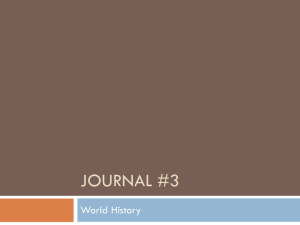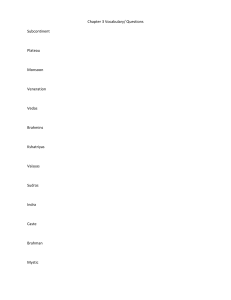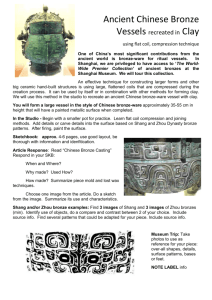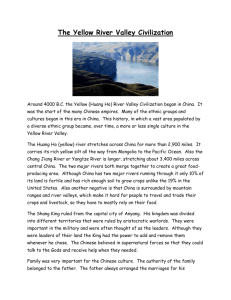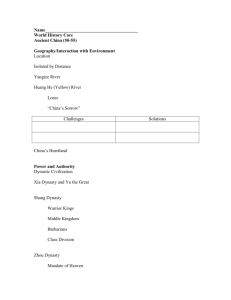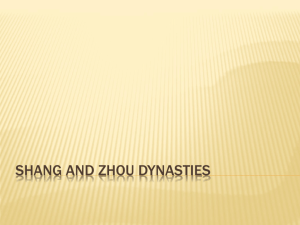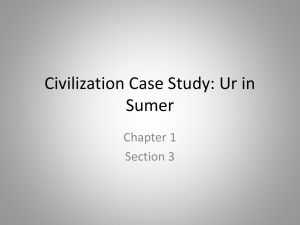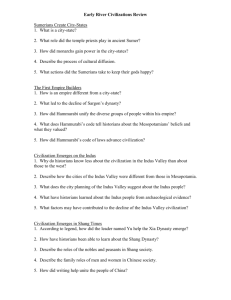HIS 105 Chapter 1
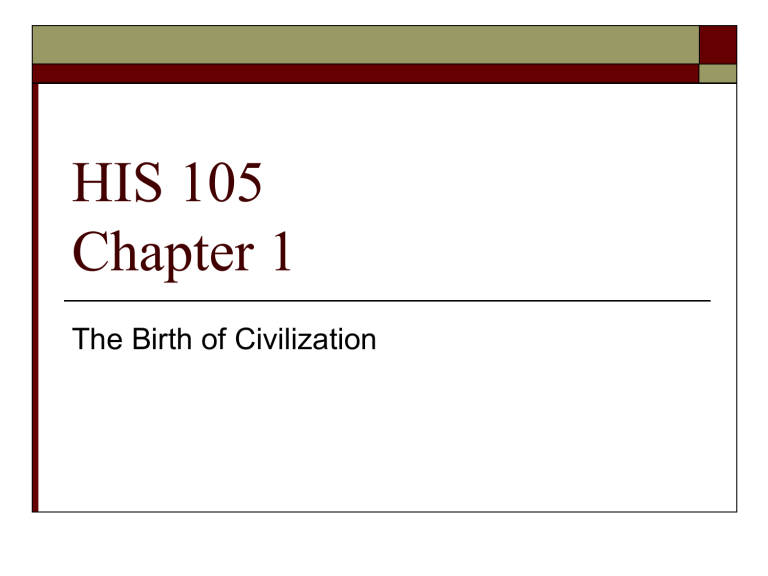
HIS 105
Chapter 1
The Birth of Civilization
Earth : approximately 6 billion years old
Human-Like Creatures: appeared 3-5 million years ago in Africa
Erect, Tool-Using Early Humans: spread over
Africa, Europe, & Asia 1-2 million years ago
Homo Sapiens: emerged some 200,000 years ago
Earliest Fully Modern Human Remains : date to about 90,000 years ago
Earliest Humans: hunter/gatherers/fishers
Agriculture began 8000 B.C.E.
Cultivated plants
Raised livestock
Made air-tight pottery for food storage
Humans settled in small communities now that they could produce their own food.
Civilization: Characteristics
Producers of food
Settled and more complex life
Increased harvests through use of irrigation
Towns and cities with impressive structures
Flourishing commerce
Developed writing to keep records and and inventories
Specialized occupations
Complex religions
Social hierarchy
Culture
Ways of living built up by a group and passed on from one generation to another
It includes:
Courtship practices
Child-rearing techniques
Material goods: Ex.- types of shelter & clothing
Ideas
Institutions
Beliefs
Language
Paleolithic Age (Old Stone)
Dates from 1-2 million years ago to about
10,000 B.C.E.
Small groups of hunters, gatherers, & fishers
- not producers of food
Used tools of stone and wood
Learned to make and use fire
Acquired language to pass on knowledge
Depended on and feared nature
Practiced religion and magic to help them with their fears
Sexual division of labor
Men hunted & fished
Women gathered plants to eat, had babies, made clothing
Because women worked with plants, the beginnings of agriculture have been attributed to them
The beginning of agriculture began the Neolithic Age
Neolithic Age (New Stone)
Began about 8,000 B.C.E. in the Near East
Shifted from just hunting and gathering to a settled agricultural way of life
Domesticated animals
Domesticated plants
Made pottery
Wove cloth from flax & wool
Cared for crops from planting to harvest
Built permanent buildings like those in Catal
Hayuk
Populations grew when there was a steady supply of food
Humans were beginning to control nature and this was an important pre-condition for the beginnings of civilization
Neolithic societies began in:
Near East – around 8000 B.C.E. (wheat)
China around 4000 B.C.E. (millet, rice)
India around 5500 B.C.E. (wheat)
Americas - around 2500 B.C. E. (corn, beans, & squash)
Emergence of Civilization
4000-1000 B.C.E.
Mesopotamia in Tigris-Euphrates River
Valley
Egypt in Nile River Valley
Indus River Valley Civilization in India
Yellow River Basin Civilization in China
All took form during the Bronze Age
All had urban centers, monumental architecture, hierarchical societies, & writing
Cities were administrative, religious, manufacturing, entertainment, & commercial centers
Writing was complex
Kings were divine
Civilizations had a king, military, aristocrats, priests, peasants, & slaves
Mesopotamia
Emerged around 3500 to 3000 B.C.E.
First city was Sumer
Farming community
People worked together for survival
As more towns formed, there was a need for central control
A king became the central ruler
Writing system was cuneiform used for records and literature like Gilgamesh
Mesopotamia
Cuneiform
Religion
Polytheistic
Gods of nature
People worked to keep gods happy
Life was harsh and gods seemed whimsical
This led to a pessimistic outlook on life and felt afterlife would be worse
Written about in Gilgamesh
– prince is looking for immortality
Gilgamesh Relief
Priests used to share the responsibility of governing, but there was a gradual separation of church and state
Ziggurats- temples of mud brick built on mound to be closer to gods and to protect it from flooding; Ex – ziggurat at Ur still exists
Ziggurat at Ur
Sumer had basic elements of civilization:
Well-defined government
Hierarchical society
Regular economic surpluses
Trade, artisans, & merchants
Writing
Religion
Unified
Lasted until about 2000 B.C.E.
Akkadian Empire
King Sargon I conquered Sumer and other city-states of Mesopotamia between 2370 and 2130 B.C.E. and created the Akkadian Empire
Introduced new language but kept cuneiform for records and literary works
Empire lasted only 200 years; overthrown by invaders
Sumerian city-states re-emerged until 2000 B.C.E.
Babylonian Empire
Established in early 18 th century B.C.E. by
Hammurabi and the Amorites when they unified
Mesopotamia
Hammurabi
Seen as one of the greatest rulers of early civilizations
Brought order out of chaos
Had officials around his empire to carry out his laws
Codified his laws: The Code of Hammurabi
Hammurabi
Code of Hammurabi
Listing of cases; what happens if…
Regulated the rights of the 3 Amorite classes: free people, state dependents, & slaves
Penalties differed according to social status: fines, corporal punishment, mutilation, & execution
Accomplishments of Babylonians
Extended Sumerian knowledge in astronomy
& mathematics
Set up 60 minute hour & 360 o circle
Expanded commerce
Used a common language
Built elaborate public buildings, royal palaces, & the hanging gardens
Babylonian Empire fell around 1600 B.C.E. to the Hittites from Central Asia
The Hittites fell to other invaders and small kingdoms arose from 1200 – 900 B.C.E.
Egypt
Emerged N.E. Africa around 3000 B.C.E.
Benefited from Mesopotamian technology and trade
Flourished for 2000 years but lasted for 3000 years
Located in fertile delta along the Nile River
Nile flooded at regular, predictable intervals
The silt left behind contributed to bountiful crops
Because of this, Egyptians felt they were pleasing their gods and so had an optimistic outlook
Egypt
Egypt was divided into 2 parts, upper and lower, until united by Narmer, the first pharaoh
Its history has been divided into 3 Kingdoms
Old Kingdom 2575-2130 B.C.E
Middle Kingdom 1938-1600 B.C.E.
New Kingdom 1540-1075 B.C.E.
There were times of instability between each period
Pharaohs
Divine rulers who were to keep gods happy
Developed large bureaucracy of priests & officials
Local governors supervised irrigation and public works
Most Egyptians were peasant farmers who were supervised and heavily taxed; some built pyramids for pharaohs like Khufu at Giza
Religion
Polytheistic for the most part
Amon-Re was the sun god who created the universe
Osiris was god of the Nile and offered the hope of immortality to masses
Pharaoh Amenhotep IV tried to create a monotheistic faith for his people
Writing
Used for texts and records
Hieroglyphics - picture symbols
Wrote on papyrus made from plant of same name
Deciphered finally by a Frenchman named Jean-
Francois Champollian using Rosetta Stone
Hieroglyphics
Science
Established 12-month year with 3 10-day weeks
Had some working knowledge of some medicines and contraceptives
Knew how to mummify a body
Culture
Virtually unchanged for thousands of years stability and optimism reflected in their view of life and the afterlife
Static and stratified society
Fairly isolated
Indus Civilization 2250-1750 B.C.E.
Known as the Indus-Valley Culture or the
Harappan Civilization
Lasted only a few centuries
This Indus culture was truly discovered in the
1920s at the Harappa site
Today there are 2 main sites Harappa and
Mohenjo-Daro plus some smaller towns
Indus Valley
Gateway to Harappa
Mohenjo Daro
They had
Bronze tools
Large cities with similar lay-outs; population of 35,000+
Writing (not yet deciphered)
A diversified social and economic organization
Having 2 cities that are so alike indicates a strong central government with good economic and communication systems
Each city had
Walled citadel on raised platform to the west; contained main public buildings, large bath, and temples town proper to the east laid out in a grid pattern
Each town had a granary, a cemetery, covered drains and sewers
House were built around a central courtyard with rooms facing inward; no windows
Economy based on agriculture
Had cloth woven from cotton
Made metal tools
Used a potter’s wheel
It is believed there was trade between the Indus
Valley and Mesopotamia because Indus stamps have been found in Mesopotamia
Material culture
Bronze and stone sculptures
Copper and bronze tools and vessels
Black on red painted pottery
Stone and terra cotta figurines
Toys
Silver vessels
Gold jewelry
Some decorative brick work
There were no mosaics, no friezes, and no large sculpture
Religion
Dominated by priestly class who were intermediaries between the people and their gods
Fertility and reproduction were the main themes
Ritual bathing
Around 2000 B.C.E. the Indus Civilization went into decline
We aren’t sure what caused its demise:
Invasion?
Flooding?
Perhaps a combination of factors
Aryans
Semi-nomadic invaders who reached India about 1800 B.C.E
They were horsemen, cattle-herders
They brought a new language, a new social organization, new techniques of warfare, and new religious ideas found in their Vedas, a sacred text
Patrilineal society
Gods were predominantly male
Marriage was monogamous but polygamy did exist; widows could remarry
Tribes ruled by chieftain chosen for his military prowess
Originally there were 2 social classes:nobles and commoners
A third was later added: Dasas or darker conquered people
Later, 4 classes or varnas:
Priestly Brahmans
Warrior nobles
Peasants and tradesmen
Servants
Dasas were excluded
This was a precursor to the rigid Indian caste system
Material culture:
Semi-nomads who had little
Had gray painted pottery
Built wood, thatch, or mud-brick houses
Measured wealth in cattle
Were good at carpentry and bronze work
Used gold for ornamentation
Made cloth from wool
Planted grains
Made and drank Soma, intoxicating drink used in religious ceremonies
Sang, danced, had chariot races, and gambled
Artisans made gold products, baskets, cloth, and pottery
Products found their way into Mesopotamia
Religion
Polytheists
Gods resembled humans
Chief god was Indra, god of war and storm
Worship based on animal sacrifice or made offerings of food
Increasing formalism as the years passed
Not yet the concept of reincarnation or transmigration
China
4000 B.C.E. agriculture began in the southern end of
Yellow River
Raised millet, cabbage, rice, and soybeans
When soil was exhausted, the town would move
Used axes, hoes, spades, and sickle-shaped knives
Had domesticated pigs, sheep, cattle, dogs, and
Chickens
Used pottery for storage
Lived in pit houses
Traditional history speaks of 3 ancient dynasties:
Xia 2205 -1766 B.C.E.; founded by Yu who controlled the flooding with dikes and canals
Shang 1766-1050 B.C.E. ; conquered other tribes and laid foundation for Chinese civilization
Zhou 1050-256 B.C.E.
Shang Dynasty
Shang and Zhou
Shang
Made up of warlike nomads
Military aristocracy went to war in chariots
Non-Shang subject people were the foot soldiers
Used spears and compound bows
Captured prisoners were enslaved
Ruled by hereditary kings with strong authority
Made sacrifices to their ancestors who interceded with the gods; also had human sacrifices
Had writing
Had calendar with a month of 30 days and a year of 360 days; made adjustments periodically
Calendar told when to plant and when to harvest
Writing taught to those in bureaucracy
Bronze first used around 2000 B.C.E. and had advanced methods of casting
Used bronze for weapons, armor, chariot fittings, and ceremonial vessels
Shang Bronze
Social Classes
Stratifies society
Weapons in the hands of aristocrats
King and his court lived in a walled city in spacious houses with opulent lifestyle
Peasants lived outside the city in cramped pit houses, underground hovels
Last Shang kings were weak, cruel, and tyrannical
Subjects rebelled
The Zhou conquered the Shang by 1050
B.C.E
Zhou
Continued Shang pattern of life and rule
Formed agrarian- based city-stae
Social hierarchy was similar to Shang
Zhou were backward people until they adopted
Shang culture
Used Chinese ideographic writing
Cast bronze for ceremonial vessels
Zhou Bronze
Mandate from Heaven
Explained why Zhou were ruling and not the
Shang
Said the “deity above” was appalled by the Shang wickedness and had withdrawn their favor from the Shang and had given it to the Zhou
Zhou Dynasty lasted until the late 3 rd century B.C.E.
Zhou king was the head of the senior branch of the family
Other relatives ruled in outlying towns
King had a group of professional bureaucrats known as the “shi” – educated men who acted as clerks, scribes, overseers, and advisors
Practiced agriculture – mainly millet, wheat, and rice
Had irrigation and iron farm equipment
As the population expanded, so did their territory
Religion
Human sacrifice ended
Males became more dominant in the family
Manners were very important to the Zhou
The rough nomads had become civilized
By 8 th century B.C.E., Zhou Dynasty was in decline.
Control diminished. Rebellions occurred
Out of this chaos came some of China’s greatest thinkers
Americas
30,000 years ago, it is believed that Asians crossed over a frozen land bridge called Beringia, to follow herds of animals
They moved into the Americas going southward and to the east
They were hunters, gatherers, & fishermen
Found fish and small game to be plentiful
Grew maize, potatoes, squash, peppers, manioc, beans, & tomatoes
As people moved further south, strong states emerged in Mesoamerica –the central part of
Mexico and Central America
Before Spanish conquest, its history is divide into 3 periods
Pre-Classic 2000 B.C.E. – 150 C.E.
Classic 150 – 900 C.E.
Post-Classic 900 – 1521 C.E.
Olmecs
Earliest civilization
2 centers: San Lorenzo 1200 – 900 B.C.E. And
La Venta 900 – 400 B.C.E.
They had monumental structures and plazas
They had large sculptures
Olmec
Andean Civilization
In South America
Farming was possible in coastal valleys near rivers
They also fished
Chavin de Huantar 800 – 200 B.C.E. emerged in highlands of Peru
Had pottery, textiles, & metals
Chavin Region
Chavin
Moche and Nazca were 2 other distinctive cultures in that area
Nazca became known for its lines depicting birds
